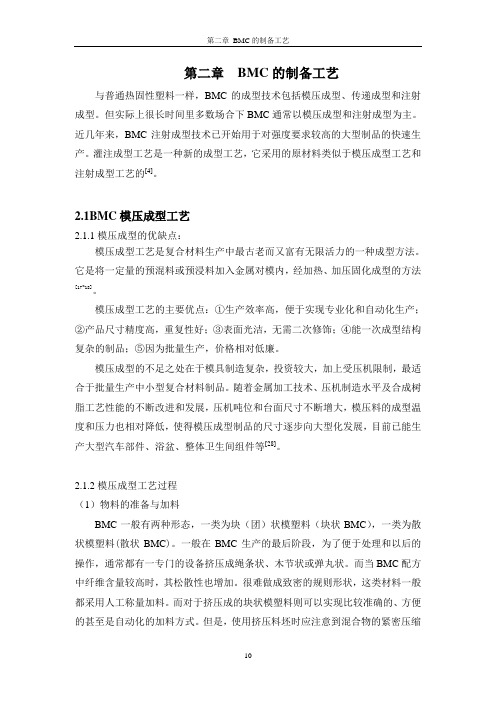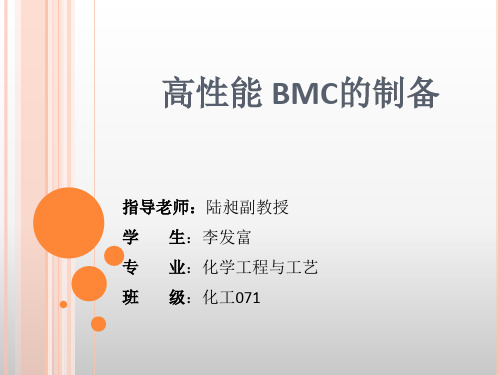高性能拜拜 BMC的制备ppt最新
- 格式:ppt
- 大小:934.00 KB
- 文档页数:23

第二章BMC的制备工艺与普通热固性塑料一样,BMC的成型技术包括模压成型、传递成型和注射成型。
但实际上很长时间里多数场合下BMC通常以模压成型和注射成型为主。
近几年来,BMC注射成型技术已开始用于对强度要求较高的大型制品的快速生产。
灌注成型工艺是一种新的成型工艺,它采用的原材料类似于模压成型工艺和注射成型工艺的[4]。
2.1BMC模压成型工艺2.1.1模压成型的优缺点:模压成型工艺是复合材料生产中最古老而又富有无限活力的一种成型方法。
它是将一定量的预混料或预浸料加入金属对模内,经加热、加压固化成型的方法[17~18]。
模压成型工艺的主要优点:①生产效率高,便于实现专业化和自动化生产;②产品尺寸精度高,重复性好;③表面光洁,无需二次修饰;④能一次成型结构复杂的制品;⑤因为批量生产,价格相对低廉。
模压成型的不足之处在于模具制造复杂,投资较大,加上受压机限制,最适合于批量生产中小型复合材料制品。
随着金属加工技术、压机制造水平及合成树脂工艺性能的不断改进和发展,压机吨位和台面尺寸不断增大,模压料的成型温度和压力也相对降低,使得模压成型制品的尺寸逐步向大型化发展,目前已能生产大型汽车部件、浴盆、整体卫生间组件等[28]。
2.1.2模压成型工艺过程(1)物料的准备与加料BMC一般有两种形态,一类为块(团)状模塑料(块状BMC),一类为散状模塑料(散状BMC)。
一般在BMC生产的最后阶段,为了便于处理和以后的操作,通常都有一专门的设备挤压成绳条状、木节状或弹丸状。
而当BMC配方中纤维含量较高时,其松散性也增加。
很难做成致密的规则形状,这类材料一般都采用人工称量加料。
而对于挤压成的块状模塑料则可以实现比较准确的、方便的甚至是自动化的加料方式。
但是,使用挤压料坯时应注意到混合物的紧密压缩会降低其贮存寿命。
这一点可能与松散的BMC内夹杂空气,抑制其聚合反应有关。
同时,空气也可以带走料团内部少量之聚合热[6]。
散状BMC,由于体积比较大,需采用具有较大装料室的模具。

BMC成型BMC(bulk molding compound)或DMC(dough molding compound)称为团状模塑料,和片状模塑料一样,都是短切纤维增强的热固性模塑料。
现今在美国、日本和我国,通常BMC和DMC 是指同一种材料,根据美国SPI的定义,BMC即为化学增稠了的DMC。
基本特征是:大多经化学增稠;玻纤含量在9%~25%之间比SMC少,故物理机械性能稍低;短切长度范围为3~25mm;填料含量大多比SMC高;物料流动性、成型工艺性及制品表观质量会比SMC好,成型薄壁、狭窄等精细复杂结构的制品突显优势。
但成型条件、工序管理、缺陷对策及模具要领等都和SMC工艺相似。
1.BMC模塑料的制备流程:第一步:将配方中的液体组份和其它助剂先在高速打浆机中充分分散、搅拌制备成糊料;第二步:将配方中的粉体填料投入sigma捏合机中稍加拌和,然后将上述准备好的糊料倒入sigma机中,进行充分的捏合拌和,大致30~45分完成液~固两相的均匀混合;第三步:将配方中的短切玻纤,在开机状态下撒落在已拌匀的膏体上,大致5~8分钟强力拌和,至玻纤都被膏体包覆浸渍即可,不宜过久而折断玻纤引起降解;第四步:倾倒出料,称重分装入不透气的薄膜包装袋中,口部扎紧,常温下自然熟化3~5天即可使用。
2.BMC混练用的捏合机一般采用Z形捏合机又称双臂捏合机或sigma桨叶捏合机,桨叶形状可有多种类型,两根桨叶的速比最好无公约数,浆叶外缘与室壁间隙约为5~8mm。
3.BMC制品所能实现或达到的尺寸要求和几何精度及尺寸误差的累积原理项目达到的水平最小壁厚mm可控的尺寸公差(名义尺寸100以内) mm 精密级的尺寸公差(名义尺寸100以内) mm 平面度(500×500) mm 0.8~1.2±0.03~0.05 ±0.01~0.02 0.30~0.504. BMC注射压缩成型工艺5. BMC配料价格和制品价格的计算实例车灯反射镜用本色BMC配方及原料价格组份及代号采购单价(含税)元/kg 注1 配方表100kg配料时的组份重量kg100kg配料时的组份价格元不饱和聚酯树脂UP 16.00 60phr注212.0 192.00(31.50) 注3低收缩、低波纹度添加剂LS、LPA(PVAc) 22.00 40phr 8.0 176.00(28.90)重质碳酸钙CaCO3(600目) 0.80 300phr 60.0 48.00(7.90)高温引发剂TBPB 40.00 1.2phr 0.24 9.60(1.60)中温引发剂140.00 0.5phr 0.10 14.00TBPO (2.30)硬脂酸锌脱模剂ZnSt 12.00 3.5phr 0.70 8.40(1.40)氢氧化钙增稠剂Ca(OH)2 10.00 0.8phr 0.16 1.60(0.30)短切玻璃纤维G.F.(6mm) 10.00 总量的16% 16.0 160.00(26.10)合计100.0 609.60(100%)注1.2008年年初的大致价格;注2.phr( Parts per hundred resin )每百份树脂(液体组份)的组份;注3刮号中数据是组份价格占原料总价的比例%.上述原料合计价格一般再追加25%~40%的加工费、管理费等即为模塑料的出厂价BMC塑壳断路器压缩成型价格分析表项目250A上盖250A底座制品照片每月需求量只5000 5000零件净重克423 770客户要求BMC之牌号、品质Tetradur F4308-7035 Tetradur F4308-7035BMC材料的采购价元/公斤含税:12.50未税:10.68含税:12.50未税:10.68压制品投料重量克435 787注1,随不同的工厂、批量多少、压机吨位、模具优劣等情况有较大差异; 注2,本表的各种价格基本参照2008年的平均水平.附记:有关BMC成型作业管理、缺陷对策都与SMC 章节相通,请编委整合。

bmc制作工艺流程英文回答:The process of bmc manufacturing involves several steps to ensure the production of high-quality products. Firstly, the raw materials are carefully selected and prepared. This includes mixing the resin, fillers, and additives in the correct proportions to achieve the desired properties. Once the mixture is ready, it is heated and melted to form a liquid state.Next, the liquid BMC is injected into a mold cavity. The mold is designed based on the desired shape and dimensions of the final product. The injection process is carried out under high pressure to ensure that the BMCfills all the intricate details of the mold. This step is crucial to ensure the accuracy and precision of the final product.After the injection, the BMC is allowed to cool andsolidify inside the mold. This process is called curing.The time required for curing depends on the size and complexity of the product. Once the BMC has solidified, the mold is opened, and the product is removed. Any excess material is trimmed off, and the product is inspected for any defects or imperfections.In some cases, additional post-processing steps may be required. This can include surface finishing, such as painting or coating, to enhance the appearance anddurability of the product. Other post-processing steps may include drilling holes, adding inserts, or assembling multiple components.中文回答:bmc制作工艺流程包括多个步骤,以确保生产出高质量的产品。


bmc制作工艺流程英文回答:BMC (Bulk Molding Compound) is a type of thermosetting composite material that is commonly used in the manufacturing industry for producing various products. The production process of BMC involves several steps, which I will explain in detail.1. Material Preparation: The first step in the BMC production process is to prepare the materials. This involves mixing the base resin, such as unsaturated polyester or epoxy, with various additives, fillers, and reinforcements. These additives can include things like glass fibers, mineral fillers, flame retardants, and pigments. The mixture is then compounded using specialized equipment to ensure a homogeneous blend.2. Molding: Once the material is prepared, it is ready to be molded. There are several methods that can be usedfor molding BMC, including compression molding, transfer molding, and injection molding. The choice of molding method depends on the specific requirements of the product being manufactured. For example, compression molding is often used for producing large, flat parts, while injection molding is suitable for complex shapes with tight tolerances.3. Molding Process: The molding process involves heating the BMC material to a specific temperature and applying pressure to shape it into the desired form. In compression molding, the material is placed into a heated mold cavity and compressed using a hydraulic press. In transfer molding, the material is first heated in a separate chamber and then transferred into the mold cavity. In injection molding, the material is melted and injected into the mold under high pressure.4. Curing: After the BMC material has been molded into the desired shape, it needs to be cured. Curing is a process that involves applying heat to the molded part to initiate a chemical reaction that hardens the material. Thetemperature and time required for curing depend on the specific resin system used. Once the curing process is complete, the part is cooled and removed from the mold.5. Finishing: The final step in the BMC production process is finishing. This involves removing any excess material, such as flash or sprue, and performing any necessary post-processing operations, such as trimming, drilling, or painting. The finished parts are then inspected for quality and packaged for shipment.中文回答:BMC(大块模塑复合材料)是一种常用于制造业的热固性复合材料,用于生产各种产品。

BMC模塑料的材料配方与主要由树脂和玻璃纤维二组分所构成的玻璃钢有所不同的是,BMC模塑料主要是由三种组分(树脂、玻璃纤维和填料〕所组成,是一类粒子分散型复合材料(树脂黏结了大量粉状填料)和纤维增强复合材料合结合起来的多相复合体系。
因此,这使影响BMC模塑科性能的因素更加多样化、复杂化.然而.遇过调节预混料中树脂、玻璃纤维、填料及各种添加剂的种类,用量及结合方式,就可配制出具有不同性能和功用的多种多样的BMC模塑料。
1、液体组份的配比国际上流行的BMC配方表中大多是以BMC组份中的液体树脂(UP+LSA)总量的百分之一为计算单位,用PHR(Parts per hundred resin)即每百份树脂的份数作为单位。
例如常规的配方表中液体组份的配比是:UP (不饱和聚酯树脂) 60phr 两者相加即100phrLSA (低收缩剂) 40phr根据低收缩剂在成型中形成微空穴的理论来抵消UP收缩的机理,通常是以低收缩剂的实际固含量来控制低收缩剂LSA的加入量:A=LSA*B/(UP+LSA) phrA—低收缩剂在BMC组份中的固含量phr 一般控制在14~18phrB—配制低收缩剂时,热塑性树脂粒料在单体苯乙烯中的浓度%常规配制时一般控制在35~45%浓度UP—UP树脂的加入量LSA—LSA低收缩剂的加入量LSA一般都采取定向采购,也可以自配,在配方设计时一定要先摸清LSA中热塑性树脂的浓度,浓度的高低直接影响LSA的粘度,粘度过高会影响随后加入粉料时的浸润,单体苯乙烯Styrene来能够降粘,可以用来改善混料时对粉体的湿润,但这不是一个好办法,过量苯乙烯的加入,在固化时用不完,残留的St会引起许多弊病,诸如强度下降、耐热性变差,甚至在成型中拔高放热峰温度,致使部品表面微裂。
一般在配方设计时要校核苯乙烯的含量,控制在45~50phr。
St在BMC中的含量用下式计算:St=LSA*(1-B)+UP*(1-C)C—UP树脂中不饱和聚酯的固含量%一般为65~68%一般的标准配方,UP的固含量是65%,LSA的固含量是40%,当按照UP:LSA=60phr:40phr时:A=40*0.4/(60+40)=16 phrSt=40*(1-0.4)+60*(1-0.65)=45 phr2、矿物填料的添加量矿物质填充料的种类虽然很多,目前常用的是碳酸钙CaCO3和水和氧化铝(ATH—alumina trihydrata)即喊三个结晶水的氧化铝,分子式为AL2O3.3H2O。